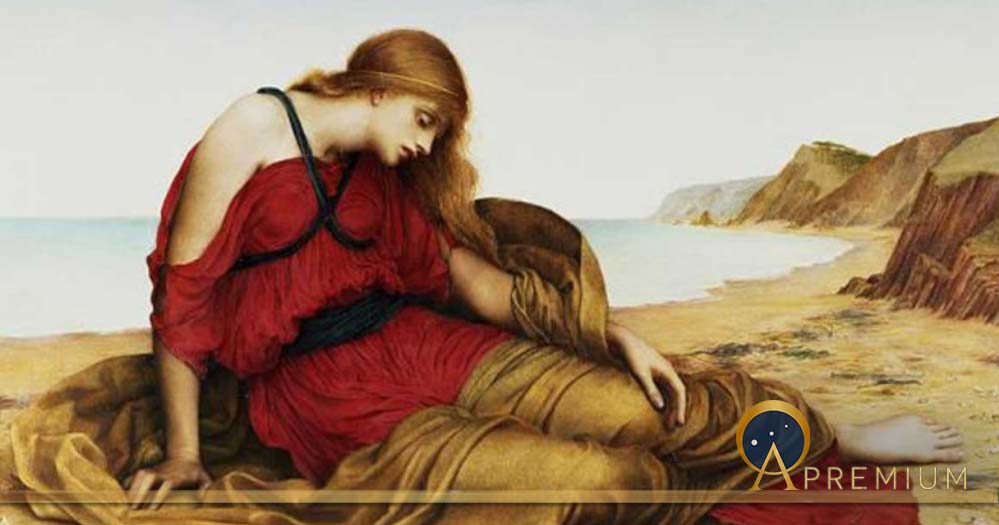Loves Of The Lady Of The Labyrinth: Ariadne Powerful Minoan Goddess
In the Myth of the Minotaur, if not for the ministrations of the humble Princess Ariadne, Theseus—the Greek hero—would not have had a prayer. Although often portrayed as a mere maiden, truth be told, providing back-up for a leading man was the very least of her qualities. Springing from the heavens, Ariadne’s origins beckon from the primordial mist of Bronze Age Minoan Crete where she was the overarching mother goddess in the Minoan pantheon—the all-important fertility goddess who is believed to have answered to such titles as goddess-on-earth, weaver of life and mistress of the labyrinth.

Minoan Snake Goddess (©Courtesy Micki Pistorius)
Ariadne Minoan Fertility Goddess
With the destiny of mortals in her hands, Ariadne was considered a bright goddess, often compared to Demeter—whose celestial origins were from Crete as well. In some ways Ariadne is analogous both to the goddess of the harvest—and her daughter Persephone—queen of the underworld. Predating patriarchy, the mother goddess’s role was paramount—in agricultural societies religion was centered on fertility and everything was centered on religion. Because Minoan Crete was a matrilineal society with women leading lives of independence, like all goddesses in the Minoan pantheon, Ariadne ruled alone without a male consort. Toward the close of the Minoan civilization—with the Mycenaeans’ influence keenly felt—Ariadne began to be accompanied by a young male consort. Her insignia, the labyrinth—a square or circular structure with multiple circuits spiraling to the center and back again—figures prominently in her mythology and is believed to have been a place of initiation where mortals moved from one realm to another with the bull-god—the Minotaur (Hades-like)—occupying its deepest and darkest center.
- The Descent of Ariadne: Minoan Queen of the Dead to Mistress of the Labyrinth?
- Pasiphae: Daughter of the Sun, Wife of a King, and Mother of the Minotaur
- The Legendary Cretan Labyrinth Cave: Inspiration for the Story of King Minos and the Labyrinth of the Minotaur?
Patriarchal Mycenaeans
The decline of the Minoan Civilization was accompanied by the expansion of the Mycenaeans—as is often the case when one culture subsumes another—when the Myceneans overtook the Minoans in about 1400 BC, they recast the Minoan myths; the invader gods married the indigenous goddesses replacing matricentric elements with patriarchal ones. By rewriting mythology, the Mycenaean Greeks provoked the systemic suppression of goddess worship which would encourage the widespread denigration of women.
Like this Preview and want to read on? You can! JOIN US THERE ( with easy, instant access ) and see what you’re missing!! All Premium articles are available in full, with immediate access.
For the price of a cup of coffee, you get this and all the other great benefits at Ancient Origins Premium. And - each time you support AO Premium, you support independent thought and writing.
Mary Naples’ master’s thesis: “Demeter’s Daughter’s: How the Myth of the Captured Bride Helped Spur Feminine Consciousness in Ancient Greece,” examines how female participants found empowerment in a feminine fertility festival. Visit www.femminaclassica.com
Top Image: ‘Ariadne in Naxos’ (1877) by Evelyn De Morgan. (Public Domain)
By Mary Naples

















Comments
Hello Mary,
Oh this is an exciting article for me too read; this must mean that there are many faces of Ariadne, obviously not the one story of Theseus I've been following.
Ever since I've read and even now continue too Study The Book's of Enoch I notice that Ancient Origin Articles that are posted have unintentionally, I suppose matched up with or confirm much of what Enoch has said took place in Earth's distant past before The Great Flood.
So far I've got about 40 to 55 names of 200 Fallen Angel's who married Human Women I know that at least, one wife's name was Ashera & Asheroth, that one of the Fallen Angel's name is Satal but in Greek you know Satal as Atlas.
With your Article it's a matter of figuring out her Angelic Father's name before her mother and where Theseus fits into the story meaning finding out who his Father was or rather grandfather.
Thank you for sharing the article of Ariadne it really is matching up with Enoch and Jubilees. Until next time Goodbye for now.